So, you’ve compiled a portfolio and even placed it on a custom site (designed with one of the best website builders, like Pixpa, isn’t it?). It sparkles brighter than a freshly waxed car. Your projects look stunning, and the “About” (or “Bio”) page positions you as a genius in your field.
But there’s one tiny problem. Once visitors land on your dazzling portfolio website, they somehow quietly vanish into the Internet void without telling you a word and never reaching out to you to collaborate. Zero calls, emails, or “Let’s work together” messages… Ouch!
Is it possible to turn those silent passive lurkers first into active clicks and then into contacts?
It surely is! This blog post is your ultimate guide to boosting visitor engagement on your portfolio website. It will help you convert visitors to engaged users from browsing to clicking to contacting you.
What Is Visitor Engagement for Portfolio Websites?
Visitor engagement on a portfolio website shows how well it holds visitors’ attention and to what extent they interact with its content. This includes:
- Clicking
- Watching
- Subscribing
- Reading
- Commenting, etc.
To put it figuratively, let’s picture portfolio websites as art shows. In this case, engaged visitors are people who actively move from artwork to artwork, ask questions, and maybe take the artists’ business cards. In contrast, disengaged ones would be those who don’t even come inside but peek through the window, shrug, and turn around to go away.
On a portfolio site, this means visitors aren’t just looking at it; they’re interacting and converting into clients. They may browse categories from the navigation menu, watch/read your content, and ultimately, tap the right button (e.g., “Contact Me” or “Book a Session”). This point of conversion is basically the end target of your portfolio website engagement.
5 Key Components to Better Engage Visitors on Your Portfolio Website
Attracting a visitor (prospective client) to your portfolio website is one thing. Quite another is turning them into an actively engaged user (and eventually—drumroll please—a real client). The good news? You just need smart design and content choices. Let’s name the most essential elements for visitor engagement on portfolio sites.
-
Straightforward, Simple Navigation
If your digital spot reminds people of a confusing labyrinth, they naturally leave. In fact, poor navigation or content layout makes 37% of visitors abandon browsing a website. That’s why clearer navigation is the number one must-do on the list of things to keep visitors engaged on portfolio websites.
Here are several practical ways to make it crystal clear:
- Keep your navigation menu simplistic. Avoid too many drop-downs in a tree-like style.
- Highlight what matters most. Use contrasting colors or highlighted/bold text for the most important call to action, such as “Hire me” or “Contact.”
- Pick familiar category names, such as Portfolio, Bio, Calendar, etc. For instance, if you really mean a CV, don’t name it “My Life Odyssey,” even if it sounds more interesting or even intriguing.
- Add a search bar (not obligatory, but a nice-to-have element)
For example:
Take a glimpse of this portfolio website created by a graphic designer using Pixpa. It has an easy-to-navigate menu and a search bar to enhance visitor engagement.
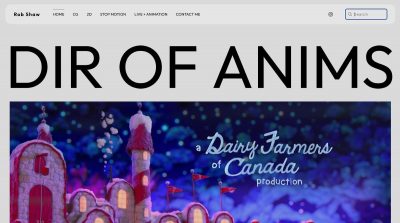
-
Enlightening Content
Why do you need to “enlighten” your web visitors?
As an online education expert, Grant Aldrich, Founder of Preppy, explains, “Portfolios perfectly show what professionals can do. Yet, they are not enough to demonstrate and share what they know. Whether it’s an educational blog or a video tutorial/guide, helpful content like this not only shapes an engaging journey from a click to contact but also establishes credibility on portfolio sites. It’s a trust-building reciprocal act: you supply people with relevant information—they entrust you with work.”
Add a Blog
To plan the right informative content for your blog and engage your portfolio website visitors in reading, look for long-tail keywords that exactly match how users search on Google. Explore keyword magic here to discover the topics that interest your audience the most and have the highest engagement potential.
For example:
Let’s take a Pixpa-built portfolio website for Sydney wedding photographers. They publish wedding photography blog articles based on people’s searches in the niche, generally or locally: “Do I Need Engagement Photos?” or “Top 25 Wedding Ceremony Venues in Sydney.”
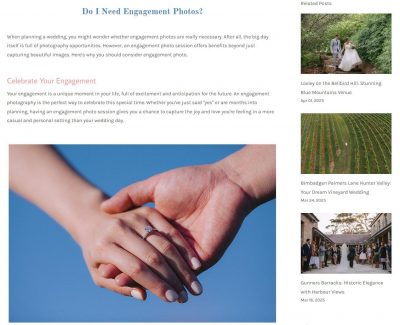
Add Guides or Other Informative Sources as a Separate Section
You don’t necessarily have to blog to inform your audience of what you know. You can also do that with tutorials, e-books, or other content pieces.
For example:
Look at another photography portfolio website (also created with Pixpa). It contains separate guides on wedding venues and things to do on the KwaZulu-Natal South Coast.
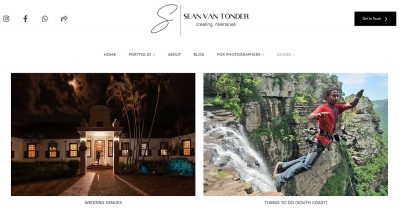
-
Video Stories
Bryan Eisenberg once said, “Facts tell, stories sell.” But we’d rather say: “Text-based stories sell, but video stories engage and stick.” Note: Viewers can memorize 95% of information when watching it as video content, compared to merely 10% when reading it as text.
Indeed, videos can make your portfolio site more memorable and dynamic, too. Online visitors become active users by hitting the “Play” button and perceiving—
- Movement
- Sound
- Continuity
- Emotion or sentiment (e.g., through your voice tone)
- Human connection
—not simply reading words.
On Your Homepage
Embedding an intro or background video at the top of the homepage is, by far, one of the best ways to incorporate video storytelling into your visitor engagement strategy for a portfolio website. It captivates visitors’ attention and stirs their senses from the first click once they lay their eyes on it.
For example:
Let’s open a musician’s portfolio website. See how this Vimeo video by Justin Kleiner engages visitors right at the moment of landing on the homepage.
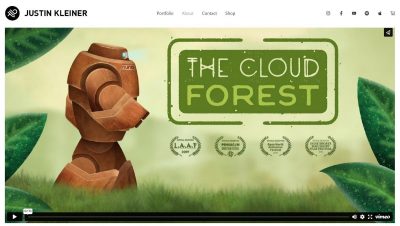
On Other Web Pages
Alternatively, you can put videos on any other web page.
For example:
Matt Callian, a freelance videographer, embedded a YouTube video accompanied by a transcript (textual bio) on the “About” page.
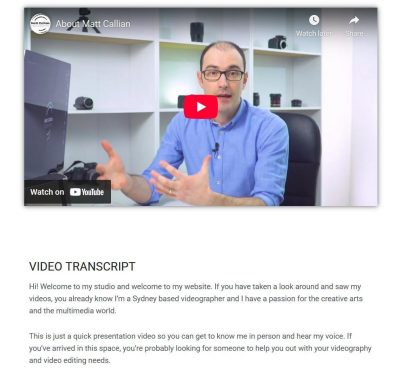
-
Social Proof
People’s validation of one another, aka social proof or influence, is yet another effective practice for engaging website visitors more authentically. It’s a huge trust-booster and click-to-contact converter. In fact, 66% of people claim that social influence increases the likelihood of purchasing a product/service.
This can be:
- Star rating
- Logo
- Badge
- Award
- Media mention
- Review
- Testimonial
Let’s examine a couple of use cases featuring social proof on portfolio websites.
Social Proof Use Case #1.
While using Pixpa to design a unique portfolio website, Rui Lourenço, a freelance photographer, created a separate page with clients’ logos. It showcases the companies that used his corporate photography services.
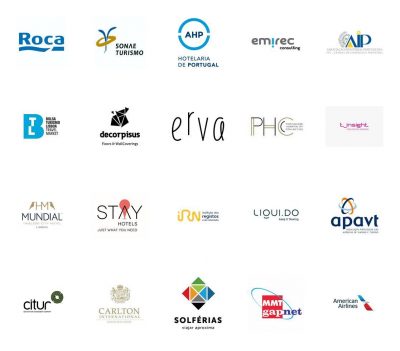
Social Proof Use Case #2.
And here’s another example of using client testimonials in a photography business. It’s a slideshow format with navigation arrows for website visitors to easily browse clients’ photos and reviews.
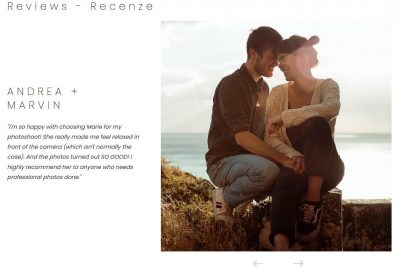
-
Interactive Content
What if none of the above works?
Perhaps you need an even higher level of interactivity to engage visitors on your portfolio website. Actually, interactive content engages users nearly 53% better than static content.
To achieve user engagement this high, consider the following elements that make site visitors interact (fill in the form, slide, double-click to reveal, etc.), not just browse idly:
- Newsletter subscription form
- Poll/survey
- Quiz
- Slider (e.g., before-and-after contrast)
- Mini-game (a portfolio website can be fun, too!)
For example:
Once you land on this portfolio website owned by Hashem McAdam, the pop-up form invites you to subscribe to his photography newsletter.
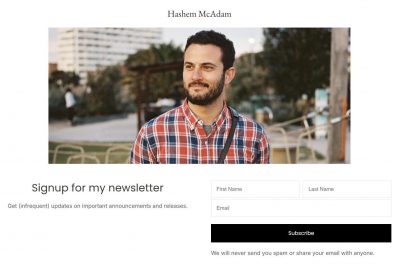
Best Strategies to Convert Visitor Engagement into Contact on Your Portfolio Website
So, you’ve engaged visitors—they’re clicking and interacting with your portfolio, testimonials, or other website elements. But how do you make them actually reach out to you and start collaborating on a project?
Follow these top five strategic steps.
Insert Compelling CTAs.
The more persuasively you’re calling to action (CTA), the higher the chance to convert engaged visitors from clicks to contacts on your portfolio website.
Grab a couple of CTAs and then learn how different freelancers use them as engaging UX design elements for better website conversions:
- Hire Me
- Don’t Just Scroll—Drop a Hi!
- Let’s Create Something Amazing for You
- Your Vision, My Skills—Let’s Talk
- Our Collaboration Starts Here
- Reach Out to Collaborate
- Drop Me a Message
- Your Next Great Project Is One Click Away!
For example:
Louisa Ferreira, a wedding and lifestyle photographer, built a portfolio website with Pixpa and dropped multiple CTAs, such as “Book a Session with Me,” “Say Hello,” or “Send Inquiry,” across the homepage.
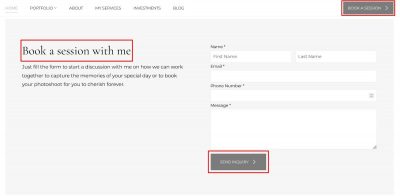
Or, here’s another CTA use case in a question-answer format on the writer’s portfolio website: “Need a Fresh Copy That Leaves a Powerful Impression?”—“Yes! Let’s Get Started.”
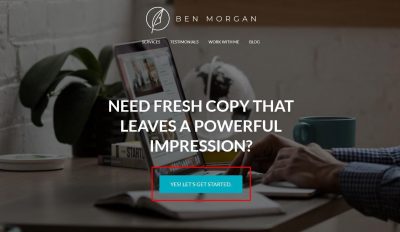
Offer a Valuable Freebie for Newsletter Subscription.
Don’t even think about skipping this section if you tap into email marketing. It will help you convert visitors into clients on your portfolio website from “Nope, I don’t feel like sharing my email address,” to “Wow, I need this! I can give my email, why not?”
On portfolio websites, professionals frequently provide complimentary perks, aka freebies, to reward active users who subscribe to their newsletters. These can be as follows:
- Downloadable e-book
- Mini-course
- Creative template
- Resource list
- Exclusive wallpaper
- Free consultation
- VIP access to a private Slack channel or Discord group
- Merchandise (aka merch)
For example:
It might also be a subscriber-only giveaway, just like here. One subscriber a month wins a custom print on a T-shirt, mug, or other merch.

Make Your Contact Form Less Complicated and Scary.
Let’s face it—some contact forms do look like interrogations or surveys: your mother’s maiden name, favorite pizza topping, what else?
No wonder people run away and never reach out. If you want to engage and convert your portfolio website visitors, keep it short and sweet with only the fundamentals:
- Name
- Email/phone
- Message box
Working in the realm of law, Kathryn MacDonell, CEO at Trilby Misso Lawyers, also highlights the importance of clarity and trust: “When people are filling in contact forms, they are already in a vulnerable spot—they’re sharing their personal details. Respect that by making this step simpler and safer. A long, demanding form may kill trust and feel like a barrier. That’s why gathering only the necessary information and spelling out the reason matters. Your portfolio website visitors should understand exactly why you’re collecting their data.”
For example:
You can throw in a friendly line like, “Don’t worry, I’m asking for your email address so I can reply to your message; I’m not a spammer.”
Enable Alternative Options for Contacting You.
Some portfolio websites offer alternative (and typically easier!) reaching-out methods for online visitors. This way, the visitor’s path from the first click to contact is shorter via:
- Upwork (as one of the most popular online platforms for freelancers)
- Calendly (or any other appointment scheduler)
- Social media DMs (e.g., a “DM Me Here” button redirecting the visitor to Instagram, LinkedIn, or Facebook Messenger)
For example:
When building a portfolio website with Pixpa, Ely Gaby, a makeup artist, embedded a WhatsApp widget for faster connection.
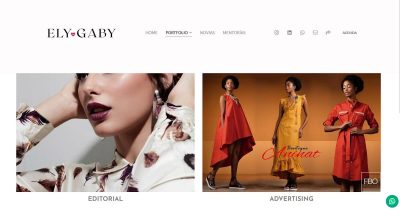
Another example:
Click the “Hire Me on Upwork” button on this graphic design portfolio website—and you’ll instantly get redirected to the freelancer’s Upwork profile.
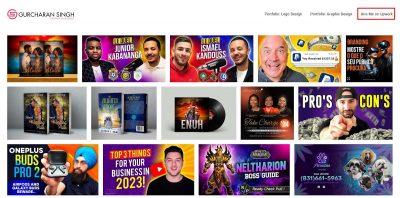
Clearly Outline What to Expect Next: Collaboration Procedure, Tool Set, or Other Things.
Your website visitors would definitely want to know what happens after they click the “Send” button and contact you. That’s when a simple “Here’s How I Work” section can be super-helpful in keeping the mystery (and anxiety!) out of the project.
For example:
Suppose you’re running a photography website featuring your portfolio. In this case, you can write “Photo Shoot Terms and Conditions,” just like on this one designed with Pixpa.
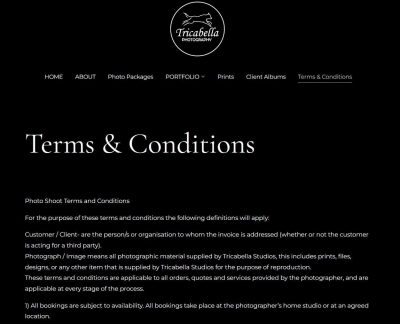
And if you’re using specific tools or platforms to collaborate with clients or collect and preserve their contact information, you should also disclose it. For instance, you might turn to contract management software to sign official agreements with clients or marketing tools to promote your creative website.
Final Word on Turning Clicks into “Stick-Arounds” and Contacts on Portfolio Websites
Today, a portfolio site is more than just a gallery of works or projects. It functions as the first digital handshake—the first contact with the future client. And thanks to these strategies, you can make it even more engaging and convincing to drive website visitor conversions (and revenues!).
And who knows, perhaps your next biggest project will soon be budding with a “Hey!” someone types in the contact form.


